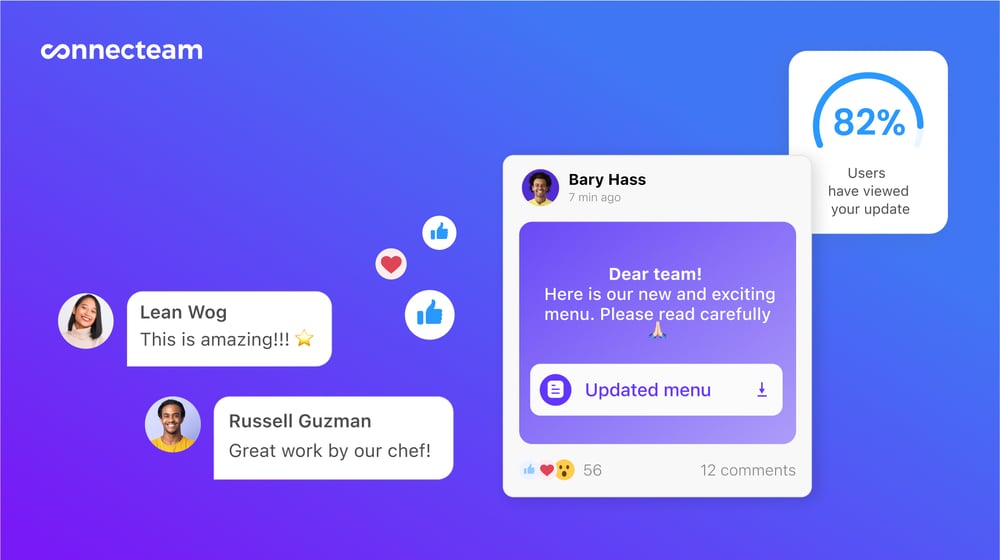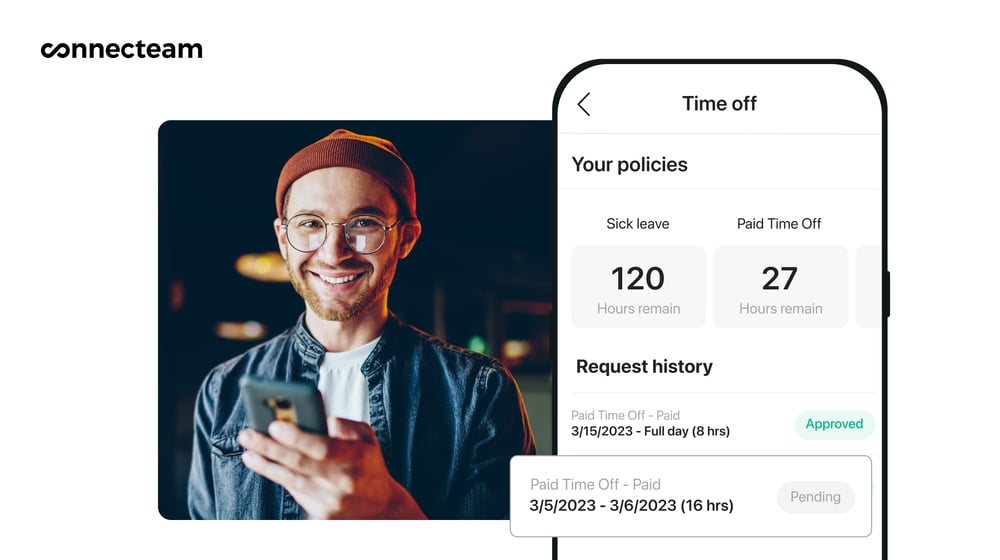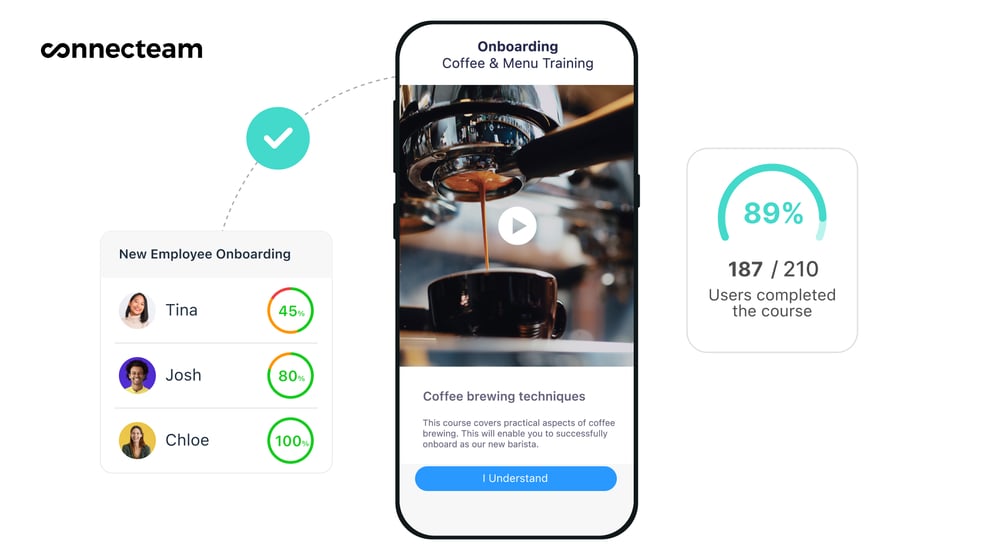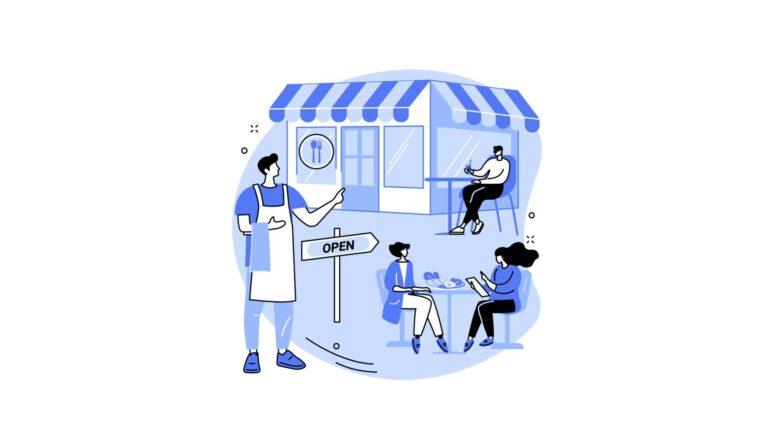This guide will teach you the ideal staff size for different restaurant types. Plus, you’ll get practical tips for hiring, training, and retaining employees—ensuring a satisfied workforce, happy customers, and a healthy bottom line.
Deciding the right number of staff for a restaurant is tough. Understaffing can lead to unhappy customers and stressed employees, while overstaffing can eat into your profits.
Getting staffing wrong also means risking a negative guest experience, a demotivated workforce, and a damaged reputation—which can impact your bottom line.
This restaurant staffing guide helps you avoid these pitfalls with practical solutions and tips on determining, hiring, managing, and retaining your restaurant’s optimal number of staff. You’ll also learn to adapt to changing business needs and align your staffing with your goals.
Key Takeaways
- Staffing problems can impact your turnover rates, profits, and service quality.
- You must familiarize yourself with front-of-house and back-of-house roles and tailor your staffing to your restaurant’s type.
- Hire employees with the skills and traits needed for the demanding restaurant environment.
- You should also adhere to US staffing laws when hiring restaurant staff.
- Managing and retaining your staff effectively includes offering competitive pay and regular time off.
Why Restaurant Managers Should Pay Attention to Staffing
Correct staffing levels can make or break the dining experience and your business’s success. Here’s why you should keep a close eye on your staffing:
Turnover rates
Understaffing in restaurants can intensify employee workload and stress, leading to burnout and increased turnover due to prolonged pressure and poor work-life balance.
The restaurant industry experiences some of the highest turnover rates across sectors. Recent data indicates the turnover rate is at an all-time high of 75%.
Financial impact
High turnover not only causes labor shortages and disrupts operations, but it also increases hiring and training costs. For instance, it can cost up to $15,000 to hire a new manager.
What’s worse, regularly hiring and training new staff leads to lost revenue due to inefficiencies and poor service. Furthermore, inadequate staffing can result in overspending on labor during slow periods or lost sales during peak times.
Service quality
64% of customers have said waiting for a service caused them to dine elsewhere. The number of employees on the floor or in the kitchen directly affects the quality of service and food. Too few staff can mean longer wait times and mistakes. Conversely, too much staff can result in an overcrowded work environment and wasted resources.
Restaurant Staff Roles
The right staffing is key to your restaurant’s success. Let’s explore the specific roles that make up your team.
Front-of-house restaurant staff roles
As the face of your restaurant, the front-of-house (FoH) team sets the tone for the dining experience.
- Hosts and hostesses play a pivotal role as your guests’ first point of contact, setting the stage for their dining experience. They manage reservations, seat guests, and monitor wait times.
- Severs and waitstaff spend the most time with your guests—taking orders, serving food and drinks, and handling payments.
- Bartenders are essential if you serve guests alcohol. They mix and serve drinks and are responsible for checking identification, managing inventory, and chatting with patrons who sit at the bar.
- Bussers assist with setting tables, clearing dishes, and maintaining cleanliness.
- Food runners quickly and efficiently deliver dishes to guests. They’re crucial in larger restaurants.
Back-of-house restaurant staff roles
The back-of-house (BoH) team is critical to food quality and preparation, kitchen management, and the overall dining experience.
- Head chefs and kitchen managers lead the kitchen. They’re responsible for creating menus, managing inventory, overseeing food preparation, and supervising kitchen staff. Plus, they handle the operational side, including staffing, budgeting, and compliance with health and safety regulations.
- Sous chefs take over when the head chef is absent. They assist with managing kitchen staff, ordering supplies, and preparing food.
- Line cooks have specific tasks or sections in the kitchen, such as grilling, frying, or sautéing.
- Prep cooks handle the preliminary food preparation. They chop vegetables, prepare meats for cooking, and perform other tasks to set up the line cooks for success.
- Dishwashers ensure all kitchen tools and spaces are clean and sanitized.
FoH and BoH staff roles
The following management roles are essential for coordinating front and back-of-house staff operations, guaranteeing guests a seamless and exceptional dining experience.
- Restaurant managers cover the entire restaurant operation. They hire staff, handle customer service issues, control inventory, and ensure the restaurant runs smoothly. They lead the FoH team, often dealing with administrative and on-floor tasks.
- Bar managers oversee the bar staff in restaurants with significant beverage service. They manage inventory, create drink menus, and ensure compliance with all regulations. They’re often involved with the bar’s financial operations, such as pricing and cost control.
This Might Interest You
Learn about different components of restaurant operation in our expert guide on restaurant operations management.
Hiring Additional Staff
Before hiring additional staff, assess your current team’s efficiency and customer service levels to ensure you’re not overstaffed, especially during off-peak hours or seasons. Sometimes, you can use efficient scheduling and cross-train existing staff to address service gaps without adding new hires.
When you do need to hire, here are key points to consider:
- Regularly evaluate your restaurant’s busiest times and customer volume. For instance, if your restaurant sees a significant increase in customers on weekends, you might need additional waitstaff and kitchen crew to meet customer demands.
- Understand which areas need reinforcement. Do you need more servers, kitchen staff, or maybe a specialist like a wine professional?
- Assess the costs of hiring, including wages and training costs. Carefully compare these expenses against your current and forecasted revenue to ensure you can afford new hires.
- Stay informed about labor laws and regulations regarding staffing, including minimum wage, overtime, and employee rights.
- Focus on hiring individuals who can truly add value. It’s better to have a smaller team of highly skilled and efficient employees than a larger team of less competent staff.
This Might Interest You
The best restaurant HR software can help you manage your restaurant workforce, handle administrative tasks, and tackle understaffing.
Optimal Number of Restaurant Employees by Restaurant Type
The ideal staff number varies based on operational hours, establishment size, and menu complexity. It increases with longer operational hours, larger restaurant sizes, and more complex menus.
Regularly assessing your staffing levels is crucial, as is adjusting them according to your restaurant’s needs and customer flow.
Here’s a general guideline for different types of restaurants.
Fast-casual restaurant
Fast-casual establishments, known for their streamlined menus and service styles, generally function well with a modest staff-to-guest ratio.
- Guest-to-staff ratio: Aim for 1 staff member per 10-15 guests. This includes kitchen staff and FoH personnel like cashiers and food runners.
- Peak hours staffing: Consider an additional 1-2 staff members during peak hours. You might need specialized roles, such as a dedicated dishwasher.
- Managerial staff: Maintain at least 1 manager to oversee operations, ensuring efficiency and quality service.
Family restaurant
Family restaurants, which cater to varied mealtimes and group sizes, require a more attentive service approach.
- Guest-to-staff ratio: Strive for 1 server per 4-6 tables, adjusting based on the complexity of the menu and the size of the groups.
- Kitchen staffing: Scale your kitchen staff in line with menu complexity. A more intricate menu might require more skilled chefs, while a simpler menu might fare well with a leaner team.
- Bar and managerial staff: Include 1-2 bartenders (if applicable) and 1-2 managers to handle restaurant operations.
Fine dining restaurant with a bar
Fine dining restaurants require a higher staff-to-guest ratio to deliver the meticulous, high-quality service expected in such settings.
- Guest-to-staff ratio: Maintain 1 server for every 2-4 table. Adjust this based on the intricacy of the service.
- Kitchen staffing: Employ a larger team of 5-10—including specialized roles like executive and sous chefs—to maintain high culinary standards.
- Bar and managerial staff: Employ 2-3 bartenders for a significant beverage service and 2-3 managers to oversee the restaurant.

Overview of Restaurant Hiring Requirements & Guidelines in the US
When hiring restaurant staff in the United States, adhering to federal and state employment laws is essential. Here’s an overview of key hiring requirements:
Age restrictions
Ensure compliance with child labor rules for employing youth in restaurants. The minimum age for non-agricultural employment is typically 14, but restrictions apply to hours and types of work for those under 18. For example, 14 and 15-year-olds can’t work more than 3 hours on a school day, and they can’t bake.
Work authorization
Employers in the US are legally obligated to verify the employment eligibility of newly hired employees. This process involves examining and retaining documentation that proves an individual’s authorization to work in the US. The most common method for employment eligibility verification is the employee’s completion of Form I-9—Employment Eligibility Verification.
Equal Employment Opportunity
Adhering to the Equal Employment Opportunity Commission’s (EEOC’s) guidelines for restaurants is crucial throughout the hiring process, from drafting job descriptions to onboarding new hires. You can’t discriminate against candidates, applicants, or new hires based on their race, color, religion, sex, national origin, age, disability, or genetic information.
Background checks
While background checks can help assess an applicant’s suitability for a position, employers must comply with various legal restrictions. For instance, it’s illegal to ask about an applicant’s criminal history on an employment application in certain states and cities. Check the laws in your state, as these regulations can vary significantly.
Minimum wage
Employers in the US must comply with federal and state minimum wage laws and offer new employees wages that meet or surpass the minimum wage. The federal minimum wage is $7.25/hour. However, many states, cities, and counties have higher minimum wage rates.
Pro Tip
Consult a legal expert or HR professional familiar with these regulations, as non-compliance can result in significant legal and financial penalties.
What To Look For in Restaurant Employees
While specific skills vary depending on the role, certain qualities are universally crucial in restaurant employees:
- Strong work ethic: Staff should be reliable, punctual, and willing to go the extra mile.
- Excellent customer service skills: Employees must engage with customers in a friendly, professional manner. This includes being attentive and patient and handling complaints gracefully.
- Team player mentality: Working well with others is essential in the collaborative restaurant environment. Look for individuals who can communicate effectively and support their co-workers.
- Adaptability and flexibility: Staff should be able to adapt to changing situations, whether it’s a sudden rush of customers or a change in daily tasks. Flexibility in scheduling is also essential, as shifts can vary.
- Attention to detail: Small details can make a big difference in the food service industry. Employees should have an eye for detail, whether in food presentation, cleanliness, or adherence to recipes and procedures.
- Problem-solving skills: The ability to solve problems quickly and effectively is crucial, especially during busy times. This includes everything from fixing order mistakes to dealing with unexpected kitchen issues.
How To Hire Restaurant Staff
Hiring effective staff is crucial for a restaurant’s success. Here’s how to do it:
Define roles and requirements
Clearly outline duties and needed skills for each role. For example, emphasize customer service for servers and culinary expertise for kitchen staff.
Create effective job descriptions
Write a job description that accurately reflects the role’s responsibilities and the qualifications required. Include details about your restaurant’s culture and what makes it a unique place to work. This clarity helps attract candidates who have the right skills and fit well with your team.
Utilize diverse recruitment channels
Use various channels to widen your reach. Post your job openings on popular and industry-specific job boards, such as:
Additionally, post them on your company website and social media platforms. You can also encourage your current employees to refer candidates who might mesh well with your team.
Screen and interview
Carefully review applications to shortlist candidates who best meet the job criteria. During interviews, ask questions that assess their technical abilities and soft skills, like teamwork and communication. Consider practical assessments, like trial shifts.
This Might Interest You
See examples of different interview questions to help you hire the best restaurant staff.
Offer comprehensive onboarding and training
Once you’ve selected a candidate, provide them with a thorough onboarding experience. This includes training them on your restaurant’s specific processes, introducing them to your team, and setting clear expectations. Effective employee onboarding process improves employee retention and ensures new hires can contribute effectively from the start.
Continuously assess staffing needs
Finally, continually assess your restaurant’s staffing levels. As your restaurant grows or customer patterns change, you may need to adjust your staffing strategy accordingly.
This Might Interest You
Learn how to manage a restaurant correctly with our hands-on approach and expert tips.
8 Tips for Managing and Retaining Staff
Don’t forget that retaining good staff is as important as hiring them. Here are some tips to effectively manage and keep your restaurant staff:
Offer competitive compensation
To address high turnover rates, offer competitive compensation that matches or exceeds industry standards. This attracts quality staff and encourages them to stay, reducing the need for frequent hiring and training.
Implement fair and flexible scheduling
Flexible schedules give employees some control over their working hours, accommodating their needs and preferences while ensuring an equitable workload. This can reduce burnout, increase job satisfaction, and lower turnover.
In fact, a recent study by the National Restaurant Association found that restaurants that offer flexible scheduling have a 25% higher employee retention rate than those that don’t.
This Might Interest You
Learn about different types of restaurant schedules and scheduling best practices in our guide on how to make a restaurant schedule.
Promote work-life balance with regular time off
Guaranteeing regular days off and vacation time helps prevent burnout and shows your staff that you value their well-being and personal time. You should accommodate time-off requests and understand the importance of work-life balance. For example, you can create a rotating schedule for holidays and weekends so everyone gets time off during peak periods.

Invest in staff’s professional development
Investing in your staff’s professional growth improves their skills and boosts their loyalty to your restaurant. You can offer specialized training programs and encourage participation in workshops and industry events. You can also set up a mentorship program where experienced staff can guide less experienced team members.

Did You Know?
Connecteam is an employee training software that lets you create custom courses and deliver them right to your employees’ mobile devices
Get started with Connecteam for free today!
Reward good performance
Recognizing and rewarding good performance motivates staff and fosters a positive work environment. You can share bonuses, give public acknowledgment, or start an employee-of-the-month program. Personalize rewards to make them more meaningful to each employee.

Did You Know?
Connecteam allows you to recognize employees with personalized badges and reward them with employee recognition gift cards.
Get started with Connecteam for free today!
Build a culture of open communication
Foster a culture of open communication by regularly giving constructive feedback and encouraging staff to share ideas and concerns. Implementing their suggestions improves the workplace and shows that you value their input.
Pro Tip
Create a suggestion box or use employee survey tools where employees can anonymously submit their feedback.
Lead by example
Your behavior sets the tone for your restaurant. Demonstrate the work ethic, attitude, and professionalism you expect from your team.
Embrace technology
Incorporating technology into your restaurant’s operations can boost efficiency and staff satisfaction while reducing workload. These tools may include:
- Staff scheduling software for creating and managing work schedules.
- Tableside tablets for in-seat diner requests and orders.
- Inventory management software for stock tracking and menu adjustments.
- Reservation apps for online table booking.
- Employee training software for skills training.
- Point-of-sale (POS) software that accommodates various payment methods and offsite events.
- Customer feedback tools to collect diner reviews.
- Digital menu apps for dynamic updates and customer engagement.
- Payroll management tools for streamlined employee compensation and financial records.
Did You Know?
Connecteam’s restaurant management software combines efficient staff scheduling, time tracking, and task management into one user-friendly platform.
Optimize Your Staff for Restaurant Success
Staffing is crucial for restaurant success, ensuring quality service, financial stability, and employee satisfaction.
To determine your staffing requirements, understand FoH and BoH roles and assess your restaurant’s needs. Then, attract candidates through various channels and select those with the right skills. Be sure to offer competitive pay, fair scheduling, and employee rewards.
Finally, use an all-in-one restaurant management software like Connecteam. It streamlines staff management, shift schedules, time off, payroll, communication, and more.
Get started with Connecteam for free today!
FAQs
Who are the key employees in a restaurant?
All employees in restaurants are important. Restaurants need hosts, chefs, servers, bartenders, bussers, managers, and more to run smoothly.
How can I handle seasonal fluctuations in customer traffic with my staffing?
Consider hiring temporary staff during peak seasons and offering more flexible hours or part-time positions during slower periods. Cross-training your team to take on multiple roles can also help.




